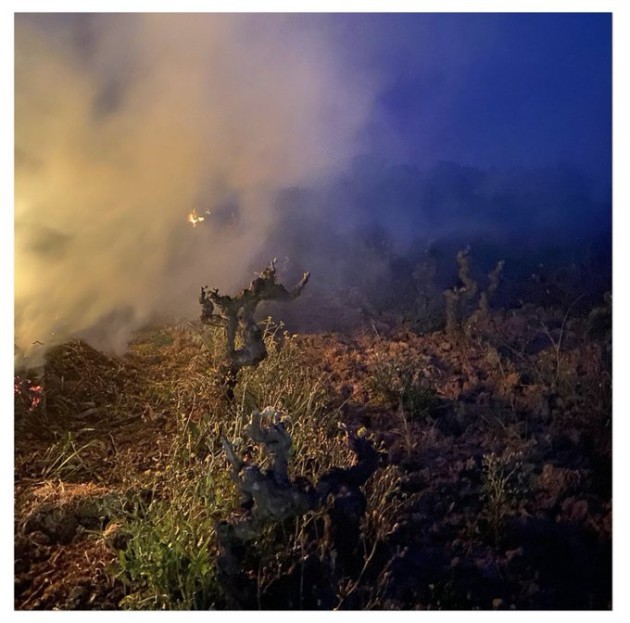
Long Read: The frosty face of climate change
The devastation caused by last week's plummeting temperatures and frosts in Europe was a pernicious reminder that climate change-induced extreme weather events are on the rise.
Winegrowers in Bordeaux, Burgundy, Languedoc-Roussillon, Champagne and the Rhône Valley are still counting the cost. The onset of sub-zero temperatures and the resulting frost attacks destroyed any chance of a healthy yield for many growers across France. The only small ray of hope emanates from the French state; Macron's government has stated its willingness to offer financial support to ailing farmers, describing the frost 'pandemic' as an “agricultural disaster”.
Social media is awash with tragic stories. British-born producer Katie Jones and her husband Jean Marc run a small domaine in the Languedoc. They told an audience of Instagram Live viewers that they've lost up to 70% of their potential yield due to the frost.
“The situation in the Languedoc is awful,” confirmed Sarah Hargreaves, owner of a Languedoc-based wine PR firm.
“We estimate that many vineyards have lost between 50% to 100% of their potential crop.”
Producers in the Rhône Valley are also licking their wounds. According to Inter-Rhône, the region is heading for its smallest harvest in 40 years.
“The frosts spared no one, and all the AOCs in the Rhône Valley are affected without exception. Negative temperatures were observed throughout the territory: from -2 to -5 degrees Celsius on average over the majority of the vineyard, and up to -9 degrees Celsius in the vineyards of Diois and Ventoux,” the organisation stated.
"We already know that some sectors have been affected in their entirety," added Philippe Pellaton, president of Inter-Rhône. "My most sincere thoughts go to all the vine-growers hard hit by this unprecedented frost episode.”
It's a similar picture in Burgundy, where grape growers have reported up to 50% losses across the entire region.
Burgundian winemaker Didier Delagrange was reported in the FT as saying: “It was like winter coming in spring... the Chardonnay was more affected because the shoots were more advanced.”
Bordeaux has also been heavily impacted, although as ever with frost, some have been spared the worst.
Hubert de Bouard told Harpers that Chateau Angelus did manage to avoid a significant loss of potential yield. Last week, the vineyards were a sea of candles, with liberal applications of anti-freeze.
Similarly, at Chateau Lagrange, directeur général Matthieu Bordes said: “Last week, we used over 8000 candles to protect our vineyard very successfully,”
However, he added: “Yet the cold war has just begun. We are on high alert throughout the month of April. Three out of the last four vintages have seen spring frost attacks.”
Back in the south, the painful irony of the devastation is not lost on Jones. In recent vintages, the Languedoc-Roussillon has experienced headline-grabbing periods of intense heat and drought. Hydric stress and excessively hot vintages have been the main focus of concern.
In November 2017, a climate change conference was organised by the French National Institute for Agricultural Research (INRA) and SupAgro Montepellier. They attempted to steer winemakers in southern France toward adopting common policies to adapt to climate change.
“Over the last decade, some of the traditional wine regions have seen their production collapse due to droughts, that are direct or indirect consequences of global warming,” said the INRA’s Marc Nougier.
Such harsh frosts were of less concern in this typically warmer region of France.
Large parts of northern and central Italy have also been hit, with Ornellaia's technical director, Axel Heinz, underlining the challenges due to a less stable climate, saying that vacillating temperatures can be more problematic and dangerous than prolonged heat.
He observes that Europe's growing seasons are becoming “unstable” – widely fluctuating spring temperatures can mean ragged bud-burst, uneven flowering and a real risk of crop devastation.
“What we clearly see is the higher frequency of climatic hazards – heat waves or monsoon-like rains storms. I believe that the ‘extreme' vintages experienced in Europe can be directly linked to climate change, and we are seeing more and more frequently extreme variations in the weather that rarely occurred in the past.”
It’s an alarming prognosis and one of which both his Italian and French colleagues are also all too well aware. This year’s frost damage continues to ram that point home.
Keywords:
- wine
- Bordeaux
- Burgundy
- frost
- Languedoc
- climate change
- Languedoc-Roussillon
- Rhone Valley
- Inter-Rhône
- frost damage




